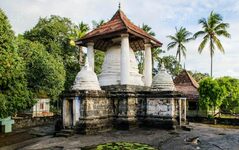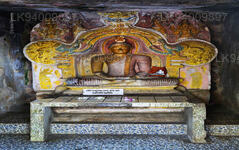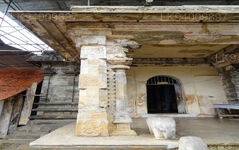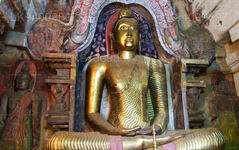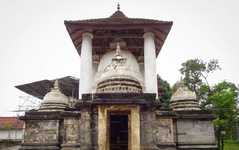
Kandy City
Kandy, a picturesque city in central Sri Lanka, is renowned for its rich cultural heritage, vibrant festivals, and scenic beauty. Nestled amidst lush hills, it is home to the Temple of the Tooth Relic, a UNESCO World Heritage Site, and offers a captivating blend of history and natural splendor.
Gadaladeniya Vihara ෴ ගඩලාදෙණිය විහාරය
Gadaladeniya Temple in Sri Lanka is an old monastery built over a rock in Diggala in the district of Kandy. According to an inscription carved into the walls, the temple was built in 1344 AD by King Buwanekabaghu the fourth. The temple was designed by the South Indian architect Ganesvarachchari in a design similar to South Indian architecture.
Gadaladeniya Temple Highlights:
- The main shrine room has one large seated Buddha statue under a Makara Thorana (dragon arch) and four standing Buddha images.
- The main seated Buddha is supposed to have been made out of the rock, plastered, and painted gold.
- The Makara Thorana is decorated with gods and heavenly bodies.
- The walls and pillars are all carved in true South Indian style with elephants, dancers, and other figures.
- The chamber within the dome has a Buddha image that was destroyed by the Portuguese.
- The shrine next to the main shrine is dedicated to God Vishnu and next to the Vishnu temple is a large stupa built on bedrock by King Parakramabaghu the fifth.
- This large main stupa has a roof held over it on four pillars, and four smaller stupas ringing it in the four cardinal directions. Each smaller step has a shrine room and flower pedestal. This structure is known as Vijayothpaya, or Vijayantha Prasana named after the palace of God Indra.
- After suffering from neglect for a few centuries, the temple was handed over to a Buddhist priest by the king Viraparakrama Narendrasinha in the 1700s and has remained with the monastery since.
- The temple was originally known as Dharma Keerthi Vihara according to the wall inscription and only received the name Gadaladeniya dur to the village of the same name where it’s located.
- Other names for Gadaladeniya are "Saddharmathilake” and “Saddharmalankaraya".
About Kandy District
Kandy district is situated in the centrel province of Sri Lanka. One of the seven World Heritage Sites in Sri Lanka, Kandy was once home to the Kandyan Kings of yore in the 16th-century and a fountainhead for all the music, arts, crafts and culture in the country. About 129 km away from Colombo, Kandy is ensconced amongst a hilly terrain and all eyes are drawn to the centre of the city, where the Kandy Lake forms a charming feature. Kandy retains great religious significance for Sri Lanka, because it is in this charming city that the Dalada Maligawa or "Temple of the Tooth" is located, within which the sacred tooth relic of Lord Buddha lies well guarded.
The Royal Botanical Garden, Peradeniya is situated about 5 km to the west of the city centre at Peradeniya and is visited by 1.2 million people per year. It is the largest botanical garden on the island. The Udawatta Kele (Udawatta Forest) is a protected sanctuary situated in the heart of the city, just north of Temple of the Tooth.
Kandy is a Sinhala majority city; there are sizeable communities belonging to other ethnic groups, such as Moors and Tamils. Kandy is second only to Colombo the center of the Sri Lankan Economy. Many major co operations have large branch officers in Kandy and many industries include textiles, furniture, Information Technology and jewellery are found here. Many agriculture research centers are located in the city.
And a fountainhead for all the music, arts, crafts and culture in the country. About 129 km away from Colombo, Kandy is ensconced amongst a hilly terrain and all eyes are drawn to the centre of the city, where the Kandy Lake forms a charming feature. Kandy retains great religious significance for Sri Lanka , because it is in this charming city that the Dalada Maligawa or Temple of the Toothis located, within which the sacred tooth relic of Lord Buddha lies well guarded.
About Central Provincce
The Central Province of Sri Lanka consists primarily of mountainous terrain. The province has an area of 5,674 km², and a population of 2,421,148. Some major towns include Kandy, Gampola (24,730), Nuwara Eliya and Bandarawela. The population is a mixture of Sinhalese, Tamil and the Moors.
Both the hill capital Kandy and the city of Nuwara Eliya are located within the Central Province as well as Sri Pada. The province produces much of the famous Ceylon tea, planted by the British in the 1860s after a devastating disease killed all the coffee plantations in the province. Central Province attracts many tourists, with hill station towns such as Kandy, Gampola, Hatton and Nuwara Eliya. Temple tooth or Dalada maligawa is the main sacred place in Centrel province.
The climate is cool, and many areas about 1500 meters often have chilly nights. The western slopes are very wet, some places having almost 7000 mm of rain per year. The eastern slopes are parts of the mid-dry zone as it is receiving rain only from North-Eastern monsoon. The Temperatures range from 24°C at Kandy to just 16°C in Nuwara Eliya, which is located 1,889 m above sea level. The highest mountains in Sri Lanka are located in the Central Province. The terrain is mostly mountainous, with deep valleys cutting into it. The two main mountain regions are the central massif and the Knuckles range to the east of Kandy.

